Enhancing Golf Course Greens with Strategic Mowing
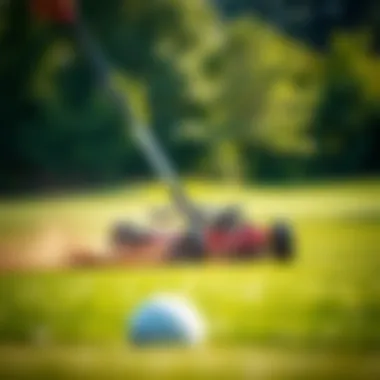

Intro
Maintaining golf course greens is an art and a science, balancing aesthetics and playability. Lawn mowers play a pivotal role in achieving the ideal conditions for both golfers and the turf itself. Selecting the right mower, understanding its role in turf management, and utilizing best practices in its operation are essential for golf course maintenance crews. The choices made here can influence everything from the quality of the grass to the overall health of the ecosystem surrounding the greens.
Choosing the right equipment involves not just a look at different mower types, but also an understanding of how cutting techniques, frequency, and even mower maintenance affect turf quality. In many ways, the green's condition reflects the choices made by greenkeepers, underscoring the importance of a strategic approach to mower selection and usage.
Research and Data Analysis
Latest Trends in Golf Course Maintenance
As the golf industry evolves, so do the tools and techniques employed to maintain greens. The shift toward sustainability in agriculture has extended into the realm of golf course maintenance. Electric and hybrid mowers are gaining traction due to their reduced environmental footprint. These mowers not only minimize noise pollution but also lower operating costs over time.
Emerging Mower Technologies
- Robotic Mowers: An increasing number of courses are utilizing robotic mowers, which can work through the night, preserving the pristine look of the greens during play hours.
- Precision Mowing Techniques: Operators now leverage technology such as GPS and data analytics to determine optimal mowing patterns, height adjustments, and turf health monitoring.
"Investing in modern mower technology can dramatically improve turf health and save on labor costs, making it a win-win for golf courses."
Statistical Insights into Turf Health
Data supports the notion that precise mowing techniques yield healthier turf. Studies show that maintaining the grass at a consistent height leads to a denser, more resilient carpet of green. Notably, research has indicated that:
- Regular Mowing: Greens mowed at the optimal height experience a reduction in disease incidence by as much as 30%.
- Cutting Frequency: More frequent mowing sessions enhance the turf’s ability to withstand drought and stress, significantly improving its longevity.
Best Practices and Techniques
Efficient Mower Operation Strategies
Understanding the interaction between mower type and turf condition is critical. In this section, we’ll look into practices that ensure efficient mower operation.
- Mow at the Right Time: Early morning or late afternoon are optimal times to mow, minimizing stress on the grass.
- Regular Maintenance: Blade sharpening is essential for a clean cut; dull blades can tear the grass rather than cut it, leaving the turf vulnerable to pests and disease.
- Right Mower for the Job: Recognizing the specific needs of the turf can enhance the choice of mower, whether it’s a reel mower for a fine finish or a rotary mower for durability.
Sustainable Practices in Golf Course Maintenance
In considering the ecological footprint of golf course maintenance, it's paramount to adopt sustainable gardening practices. Lawn mowers can contribute to sustainability by enabling the following:
- Grasscycling: Leaving clippings on the greens can provide essential nutrients to the grass, reducing the need for fertilizers.
- Integrated Pest Management: By combining different practices such as mowing heights and timing with field scouting, courses can minimize the impact of pests without heavy chemical use.
Pest and Disease Management
Common Pests and Diseases in Golf Courses
Despite all precautions, greens are still susceptible to various pests and diseases. Awareness and proactive management are key.
- Grubs: These can devastate turf roots and are often a result of poor mowing and moisture retention.
- Mold: High humidity and poor air circulation can lead to mold outbreaks, which threaten green health.
Integrated Pest Management Strategies
Adopting an integrated pest management approach is crucial. This includes:
- Regular Monitoring: Keeping an eye on pest populations allows for early intervention.
- Cultural Practices: Adjusting mowing height can create unfavorable conditions for pests while promoting healthy growth.
Prelude to Golf Course Greens
The role of golf course greens in the overall design and functionality of a course cannot be overstated. These carefully curated patches of grass are the centerpiece of a golfer's experience, influencing both the playability and aesthetic appeal of the entire course. In this segment, we shall explore what makes greens so critical, taking into account factors such as usability, maintenance, and their overall aesthetic contribution to the landscape.
Importance of Greens in Golf Course Design
Greens are often referred to as the heart of a golf course. They are not only where the game culminates, but they are also designed to provide unique challenges to players. A well-maintained green can dramatically enhance a golfer's experience. There are a few key reasons why greens are essential to golf course design:
- Playability: The smoothness and speed of greens can significantly affect how a ball rolls after putting. Uneven or poorly maintained greens can lead to frustration for golfers, while expertly groomed greens enhance gameplay, making it an enjoyable experience.
- Aesthetic Appeal: Greens serve as vibrant focal points amidst the terrain and often showcase the skill of turf management. The richness of color, evenness of cut, and overall health of the turf contribute to the visual pleasure of a course, making it inviting for players and spectators alike.
- Strategic Elements: Golf course architects often design holes with specific playing strategies in mind, depending on the contours and conditions of the greens. Elevation changes, slopes, and obstacles around the green demand different skill levels from golfers, making the game a richer experience.
Because of these factors, golf courses invest a great deal of time and resources into optimizing their greens. They know that well-maintained greens keep players coming back time and again.
Factors Influencing Turf Quality
Turf quality on golf course greens is influenced by several interconnected factors, which include:
- Grass Type: Different grass species thrive in varying climates. For instance, bentgrass is favored in cooler climates because of its ability to recover quickly and create a dense surface, while Bermuda grass is more often grown in warmer regions for its durability.
- Water Management: Optimal irrigation practices play a pivotal role in maintaining turf health. Watering routines, drainage systems, and even rainfall patterns can lead to either lush greens or parched patches.
- Soil Quality: The foundation of any green is the soil underneath it. Factors such as pH levels, nutrient density, and aeration directly affect root health and overall grass vigor. A well-aerated soil fosters deep-root development, enabling stronger grass that can withstand wear and tear.
- Mowing Techniques: Regular mowing at the right height is vital for turf health. Cutting too high can lead to uneven growth, while cutting too low may stress the grass, leading to potential diseases.
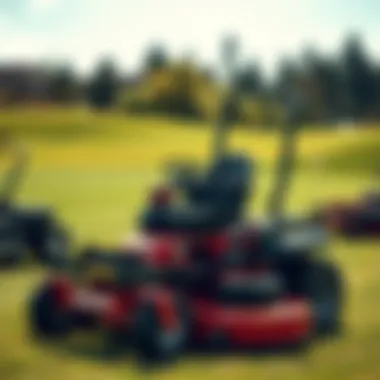
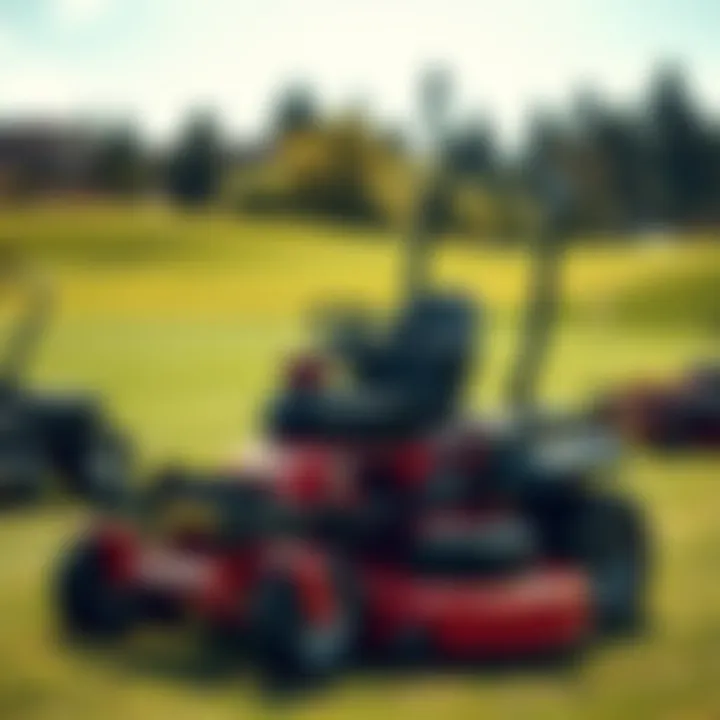
By understanding and managing these elements properly, golf course maintenance teams can ensure that their greens remain not only healthy but also capable of offering an exceptional golfing experience.
Types of Lawn Mowers for Golf Course Greens
Understanding the different types of lawn mowers available for golf course greens is essential for maintaining optimal playability and aesthetics on the course. The choice of mower can significantly affect turf health, cutting quality, and overall maintenance efficiency. In this section, we will delve into various mower types, highlighting their specific benefits and considerations, and why selecting the right one matters.
Reel Mowers: Precision and Efficiency
Reel mowers are often the preferred choice for greens maintenance, as they provide a clean and precise cut that is crucial for turf health. Their design features a series of blades rotating in a cylindrical fashion, allowing for a scissor-like cutting action that minimizes damage to grass blades. This precision is vital because it reduces stress on the grass, encouraging healthier growth and a denser turf.
Benefits of Reel Mowers:
- Clean Cut: The scissor action preserves the integrity of the grass, which can lead to improved recovery times after mowing.
- Adjustable Heights: Golf course managers can easily adjust cutting heights to meet the specific needs of the greens, promoting optimal turf conditions.
- Low Scalping Risk: The design reduces the risk of scalping, which can happen with other mower types when cutting too low.
It's important to invest in regular sharpening and maintenance of the blades to ensure continued efficiency. Neglected blades can cause tearing rather than cutting, leading to a host of problems for the turf.
Rotary Mowers: Versatility for Varied Conditions
Rotary mowers, while traditionally considered more suitable for roughs and fairways, also play a role in golf course maintenance. Their versatility allows them to handle a variety of turf conditions, from uneven terrain to taller grasses. Rotary mowers function with a horizontal rotating blade that chops grass down to a specified height, which is especially useful during certain seasons when grass growth is rapid.
Considerations for Rotary Mowers:
- Flexible Height Adjustments: Most rotary mowers offer multiple height settings, making them adaptable for different types of grass and conditions.
- Speed and Efficiency: They tend to cut grass faster than reel mowers, which can be a time-saver for maintenance crews working under tight schedules.
- Robust Design: Many rotary models can handle thicker grass and debris, making them a solid choice for seasonal transitions.
However, it's essential to monitor the cutting height closely to avoid scalping or uneven cuts, which can unsightly impact the greens' appearance.
Robotic Mowers: The Future of Turf Management
In the realm of golf course maintenance, robotic mowers represent an innovative shift towards automated solutions. These mowers operate independently and are equipped with advanced navigation systems. While they are still emerging in the golf course maintenance sector, their potential benefits are considerable.
Key Advantages of Robotic Mowers:
- Labor Efficiency: By automating mowing tasks, golf courses can redirect human resources toward other essential maintenance activities.
- Consistent Cutting: Robotic mowers offer consistent cutting patterns, which can lead to a uniform appearance across the greens.
- Environmental Benefits: Many models are battery-operated, reducing the carbon footprint associated with gas-powered equipment.
However, investment costs can be high, and initial setup requires careful planning regarding obstacles and turf layout. Continuous monitoring is also essential to ensure that technological hiccups do not hinder mower performance.
Operational Principles of Lawn Mowers
Understanding the operational principles of lawn mowers is essential for effective maintenance of golf course greens. This knowledge helps course managers make informed decisions about mowing techniques and equipment usage. Essentially, it is not just about cutting grass; it’s about fostering an environment where the turf thrives. Proper mowing practices encourage yielding healthier, denser grass, which is crucial for playability and overall aesthetics.
How Mowing Affects Turf Health
Mowing has a profound effect on turf health that goes beyond just appearance. When done correctly, it promotes lush growth and minimizes pests and diseases. Here are several important aspects to consider:
- Promotes Dense Growth: Regular mowing encourages the grass to spread and fill in bare spots. This growth habit establishes a thicker canopy that can better resist weed intrusion.
- Nutrient Intake: Cutting the grass at the right height allows for improved sunlight penetration, which is vital for photosynthesis. Taller grass blades have a greater surface area to absorb light.
- Root Health: Maintaining the right mowing height promotes deeper root systems. Strong roots anchor the grass and help it withstand heat and drought stress better.
- Disease Prevention: Regular mowing can help reduce the risk of diseases such as dollar spot and brown patch by allowing air and sunlight to reach the turf.
"A well-mowed lawn is not just a visual treat; it is a healthy ecosystem where each blade plays its part in sustaining the whole."
The key lies in not just mowing, but mowing wisely. Adjustments based on weather, season, and grass variety are crucial.
Blade Types and Their Impact on Cut Quality
The blades of a mower significantly determine the quality of the cut, which in turn affects turf health. Different blade types cater to specific mowing conditions, and understanding these can elevate mowing efficiency. Here are the common blade types and their impacts:
- Reel Blades: These blades operate by cutting grass with a scissor-like motion. They are exceptionally effective for fine turf, leaving a clean, precise cut that encourages healthier growth.
- Rotary Blades: More versatile, these blades are ideal for rougher, thicker grass. However, they can sometimes tear instead of cut, leaving jagged edges that are prone to disease.
- Hybrid Blades: A blend of both reel and rotary features, these blades aim to provide the benefits of both types. They can reduce the disadvantages commonly seen with each style alone.
Using the correct blade type not only improves the cut quality but also enhances the overall health of the grass, making it critical to select appropriately for the specific conditions of a golf course.
Maintenance Requirements for Mowers
Maintaining lawn mowers is critical for the optimal functioning of golf course greens. When mowers are not properly maintained, it can lead to inefficient cutting, uneven surfaces, and ultimately, poorer turf health. Proper maintenance not only extends the lifespan of the equipment but also enhances the overall appearance and playability of the greens.
Routine inspections, performance checks, and cleanings are essential. Paying attention to components such as blades, belts, and filters can significantly influence the mower's efficiency.
Routine Maintenance Practices
Establishing a regimen for routine maintenance is akin to following a scorecard on the golf course—each step is essential for achieving a happy ending. Here's how to keep those mowers in tip-top shape:
- Regular Inspections: Conduct regular checks for wear and tear. Look out for loose bolts, damaged cables, or worn-out tires.
- Blade Sharpening: Keeping the blades sharp is one of the most significant aspects of maintenance. Dull blades tear the grass rather than cut it cleanly, causing stress to the turf. Aim to sharpen blades after every 20 to 25 operating hours.
- Cleaning the Deck: After each mowing session, cleaning the mower deck helps to prevent clumping and rusting. Grass clippings can trap moisture, which is not ideal for metal components.
- Fluid Levels: Regularly check oil, hydraulic fluid, and fuel levels. Change the oil as recommended, usually every 50 hours of operation.
- Battery Maintenance: If your mower has a battery, ensure it's charged and terminals are clean to prevent corrosion.


By adhering to these practices, golf course maintenance crews can ensure that their mowers run smoothly and efficiently.
Troubleshooting Common Issues
Even with routine maintenance, issues may arise. It’s essential to recognize problems quickly, as delays can compound and lead to costly repairs. Some common problems include:
- Unresponsive Engine: This could be linked to fuel issues, spark plugs, or a dead battery. Checking fuel lines and ensuring batteries are charged often resolves the issue.
- Uneven Cutting: If the mower leaves an uneven cut, it might be time to check the blade height and ensure the cutting deck is level. Uneven terrain can also affect cutting.
- Excessive Vibration: A vibrating mower is usually a sign that components are loose or that the blades are damaged or imbalanced. Tighten fittings and inspect the blades for damage.
- Overheating: This can occur if the mower is working harder than it should. Checking oil levels, ensuring cooling air can flow freely, and not overloading the mower can reduce overheating risks.
When troubleshooting, a methodical approach is key. Starting from the simplest solutions and working toward the more complex can save both time and resources.
"A stitch in time saves nine," is a fitting adage for mower maintenance, emphasizing that timely care can prevent larger, more complicated issues down the line.
Maintaining lawn mowers is not merely a chore but a vital investment in the health and appearance of golf course greens.
Cutting Techniques and Strategies
The strategies involved in cutting grass on golf course greens are not merely about keeping the grass at a manageable length; they fundamentally influence the overall health of the turf and its aesthetic appeal. The precision of cutting techniques can be the fine line between a mediocre and a flawless green. By employing the right techniques, one can enhance turf quality, promote healthy growth, and ensure consistent playability that golfers appreciate.
Optimal Cutting Heights for Various Turf Types
Different types of grass have varying needs when it comes to cutting heights. For instance, Bermuda grass thrives when cut to a height of approximately 1/2 to 1 inch, while Poa annua may require a slightly higher cut, around 1 to 1.5 inches, to ensure good health throughout its growing season. This is crucial—if the grass is cut too short, it can lead to scalping, which exposes the roots and can cause stress to the plants.
When determining the optimal height for cutting, several factors come into play:
- Grass Type: Understanding the specific species of grass on the green is vital.
- Weather Conditions: During hot and dry months, a higher cutting height may be beneficial to shade the roots from direct sun.
- Playability: Consideration of player preferences is also important. For example, lower cuts may yield a faster green, appealing to avid golfers who prefer speed.
In summary, adjusting the cutting height based on species and environmental factors ensures a healthy green while catering to the needs of the golfers.
Frequency of Mowing: Best Practices
The frequency of mowing is as important as the height. Regular mowing encourages healthy growth and helps in maintaining thickness, which in turn promotes a dense turf that can withstand foot traffic. However, it’s not a one-size-fits-all formula. Generally, during peak growing seasons, mowing every 3 to 5 days is advisable. Conversely, as growth slows in cooler months, extending this interval to about 7 to 14 days may be sensible.
Some key considerations when deciding on mowing frequency include:
- Growth Rate: Monitoring grass growth can indicate when it's time to mow.
- Weather Conditions: Rain and cooler temperatures can slow growth, potentially allowing for longer intervals between mows.
- Playing Schedule: High-traffic times, like weekends, may necessitate more frequent mowing to ensure optimal conditions for players.
To sum it up, timing of mowing must take into account natural growth cycles and scheduled events on the course. A well-timed mowing regime fosters a healthy turf while accommodating golf play.
Techniques for Achieving a Level Surface
Achieving a level surface on greens is a subtle art and science that significantly affects playability. Uneven surfaces can disrupt ball roll and lead to unpredictable gameplay. Therefore, dedicating time to leveling techniques pays off in improved player satisfaction and overall turf condition.
Key strategies to keep in mind include:
- Regular Topdressing: Applying a fine layer of sand or soil amendments can help fill in low spots and smooth out the surface over time.
- Verticutting: This method cuts grooves into the turf, alleviating thatch buildup and promoting better drainage and airflow.
- Rolling: Light rolling after mowing compresses the soil slightly and can help smoothen the surface.
Incorporating these methods into regular maintenance schedules will contribute to the green's flatness and overall performance.
Quote: "Attention to detail in mowing not only reflects care but also plays a significant role in course management and player experience."
Through attentive mowing strategies, including optimal cutting heights, frequency of mowing, and surface leveling techniques, golf course managers can develop and maintain exceptional greens that meet both aesthetic and practical requirements. This continual optimization can turn a decent course into one that players return to time and time again.
Economic Considerations in Mower Selection
Selecting the right mower for golf course greens is not merely an aesthetic choice; it significantly impacts the operational budget and overall quality of the course. Economic considerations intertwine with functionality, and understanding these can help golf course managers make informed decisions.
Cost of Different Mower Types
When weighing mower options for maintaining greens, it’s essential to look at different cost aspects. Mowers vary widely in price depending on their type and features. For instance, reel mowers tend to be more expensive upfront but bring a precision cut that can enhance turf quality significantly. They also require a more involved maintenance process, which can add to ongoing costs.
On the flip side, rotary mowers often come at a lower acquisition cost and are rugged, handling a variety of terrain with ease. However, this versatility might come at a cost to the quality of cut—something that can be particularly noticeable on premier greens.
In a nutshell, you might consider the following points:
- Initial cost: Factor in not just the purchase price but also warranty and service agreements.
- Long-term savings: Take into account longevity and maintenance expenses over time.
- Quality impact on plays: A better mower could lead to higher customer satisfaction and possibly increased revenue.
"Investing wisely in mowers not only improves turf quality but can ultimately pay for itself through customer satisfaction and loyalty."
Value of Labor vs. Equipment Cost
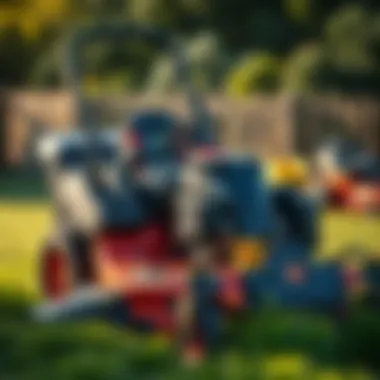
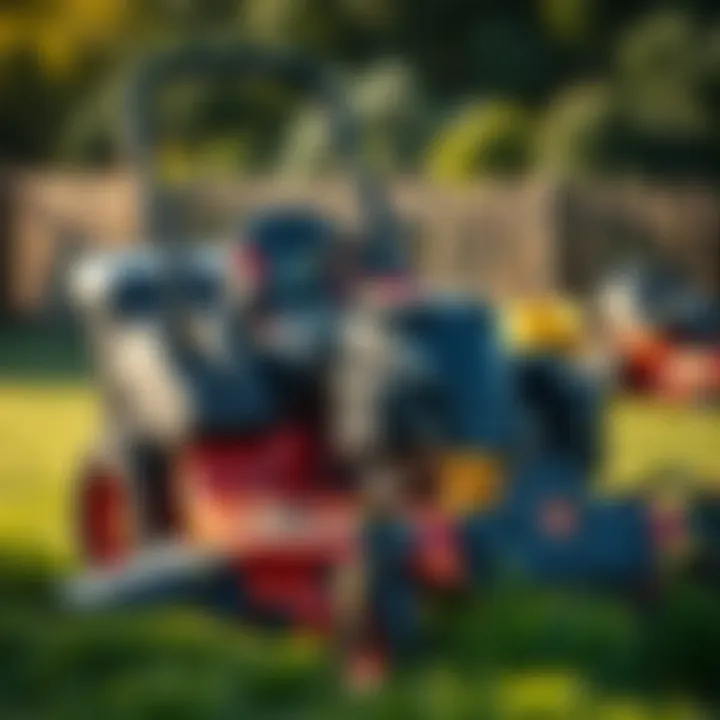
The relationship between labor costs and equipment expenditure is another vital consideration. In many cases, it’s the human resources that add to the overall expense when caring for golf greens. Whether you hire a full-time crew or couple seasonal staff with automated mowing machines can significantly affect the financial layout.
Many golf courses are opting for a mix of labour and machinery to maximize efficiency:
- Manual labor offers a crafted touch but often takes more time.
- Advanced mowers can cover substantial ground in less time, allowing staff to concentrate on other essential maintenance tasks.
A good mower can minimize labor time, freeing up workers to focus on different areas of greens management like overseeding or fertilizing. Ultimately, while machinery and initial sales might pinch your budget, they can reduce labor hours significantly, leading to cost savings over time.
Upon reflection, choosing the right mower is a balancing act: investing in the right equipment today could lead to savings in labor costs tomorrow, paving the way for a greener golf course.
Environmental Implications of Mowing Practices
In the realm of golf course management, understanding the environmental implications of mowing practices is essential. Mowers, while integral to maintaining the aesthetic and functional qualities of greens, also play a significant role in ecological footprints. Undoubtedly, decisions made about equipment and techniques have far-reaching implications for both sustainability and ecological health.
Carbon Footprint of Lawn Equipment
The operation of lawn mowers contributes to the overall carbon footprint of a golf course, which can be surprisingly substantial. Conventional gas-powered mowers release greenhouse gases into the atmosphere, notably carbon dioxide and methane. To put it into perspective, one hour of operating a typical gas mower can produce emissions equivalent to driving a car for several hours.
Shifting towards electric mowers helps mitigate this issue. These mowers not only reduce emissions but often have lower operational costs over time. Additionally, they lessen noise pollution, creating a more serene environment for players and wildlife alike.
- Statistics relevant to emissions:
- Gas-powered mowers can emit about 87 pounds of carbon dioxide per hour of use.
- Electric mowers, in comparison, typically yield zero emissions at point of use, though power source sustainability varies.
Understanding the carbon output of equipment is a critical first step for golf course managers aiming to implement greener practices.
Sustainable Mowing Practices
Adopting sustainable mowing practices is not just a trendy notion; it is an imperative for preserving both the integrity of greens and the environment. One of the most effective methods is practicing mow-once techniques, which emphasize maintaining longer grass heights. This promotes thicker turf that can better resist pests and diseases. Furthermore, a taller cut means a healthier root system, leading to improved soil quality and moisture retention.
Here are some practical sustainable practices:
- Mulching: Using mulching mowers returns clippings back to the lawn, providing nutrients and reducing the need for chemical fertilizers.
- Timely Mowing Schedules: Adjusting mowing frequency based on grass growth and weather trends helps avoid unnecessary cuts, leading to lower fuel usage.
- Soil Health: Engaging in core aeration and overseeding alongside mowing helps build resilient turf, thus decreasing reliance on fossil-fuel-heavy machinery.
Reducing the quantities of chemical inputs is essential, and sustainable mowing practices can support this by enhancing the natural resistance of grasses. This translates into healthier greens that play well, remain beautiful, and have less negative impact on the local ecosystem.
In summary, the importance of understanding the environmental implications of mowing practices cannot be overstated. Whether consciously minimizing the carbon footprint through equipment choices or implementing sustainable mowing techniques, courses can effectively contribute to a greener future.
Case Studies of Effective Mowing Regimens
Exploring effective mowing regimens through case studies is not just a luxury for those tasked with maintaining golf courses—it's a necessity. These real-world examples shine a light on practical applications of theories in turf management. They offer a window into how innovative mowing strategies can yield significant benefits, such as improved turf health, aesthetic appeal, and even enhanced player experience.
Successful mowing regimens are deeply intertwined with the long-term viability of golf course greens. By analyzing specific cases, golf course managers can glean insights into what works and what doesn’t, ultimately leading to more informed decisions. It's all about adopting tried-and-true practices while keeping an eye on emerging technologies and methodologies. This approach fosters an environment where continuous improvement can thrive.
Successful Golf Courses and Their Mowing Choices
Consider the example of Pinehurst No. 2 in North Carolina, known for its unique challenges and commitment to traditional practices. The greens there are frequently mowed at a higher height than many other courses, which promotes a thicker turf that withstands wear and tear better. The maintenance crew utilizes reel mowers, ensuring precision cuts that favor the delicate Bermuda grass prevalent in the region. This choice helps preserve the greens' integrity while maintaining a fast yet playable surface.
Another example is Oakmont Country Club in Pennsylvania, famous for its rigorous upkeep and the role of mowing in maintaining its iconic greens. The team employs a frequent mowing schedule, sometimes every day during peak season, using rotary mowers that can adjust to varying turf types across the course. This attention to detail pays off, as players often praise the consistency of the greens, a key aspect in high-level play.
"The right mower, at the right time, can make all the difference in quality. It's not just about cutting grass; it's about nurturing it."
Lessons Learned from Mowing Trials
Learning from past experiences in mowing practices can be an enlightening journey. A notable trial conducted at a university-affiliated golf course analyzed the effects of different mowing frequencies on turf vitality. The results revealed that greens mowed every other day showed improved turf density and health compared to those mowed weekly. This led to encouraging findings that frequent mowing could be more advantageous than traditionally believed, draining less energy from grass while promoting robust growth.
One particularly telling lesson came from a trial on the environmental impact of mowing during various times of the day. Cutting during the early morning hours proved beneficial—it allowed for less stress on the grass due to cooler temperatures, reducing moisture loss and promoting recovery. Managers started to adjust their mowing schedules based on these findings to enhance the overall resilience of their greens.
In essence, these case studies and trials illustrate that mowing is not simply a mechanical task; it's a complex activity with tangible consequences on turf health and course aesthetics. Armed with these insights, golf course managers can adopt new practices that move beyond conventional wisdom, leading to improved conditions that benefit both players and the environment.
As the golf industry continues to evolve, it’s imperative to stay learning from successful precedents while experimenting with new methods tailored to unique challenges. The case studies emphasize that a thoughtful approach to mowing can transform golf course greens, making them not only more beautiful but also more sustainable.
Culmination
In wrapping up our discussion on the role of lawn mowers in optimizing golf course greens, it becomes clear that the maintenance of these vital areas goes beyond mere aesthetics and into the realm of functionality and player experience. The choices that golf course managers make regarding the type and operation of mowers have direct consequences on the overall health and playability of the greens. Investing in the right cutting techniques, understanding the varying needs of the turf, and adapting to environmental considerations are all essential elements for successful golf course maintenance.
The Future of Mowing in Golf Course Maintenance
Looking ahead, one clearly sees a landscape that is evolving rapidly due to technology and sustainability initiatives. With advances in mower technology such as robotic cutters, golf courses can potentially reduce labor costs while maintaining or even improving turf quality. These machines are designed to operate efficiently and can make precise cuts, which is fundamental for keeping the greens in prime condition.
Moreover, as environmental awareness grows, there is an increasing push towards sustainable practices. This includes choosing equipment that minimizes carbon footprints, such as electric mowers. Incorporating these green technologies can not only save money in the long run but also reflect well on the course's commitment to environmentally responsible management.
As managers embrace these changes, focusing on education and consistency in mowing practices will be paramount. No longer is it enough to merely cut grass; it's about managing a complex ecosystem that supports both the sport of golf and broader environmental goals.
"The future of golf course maintenance lies in marrying tradition with innovation, ensuring sustainability while upholding the standards players expect."















